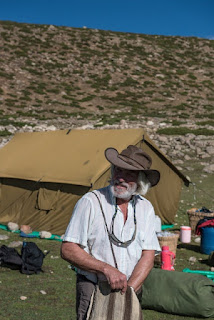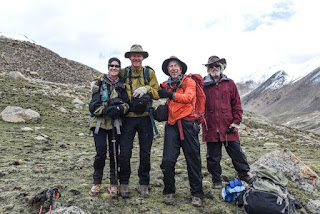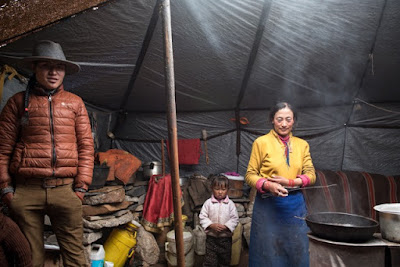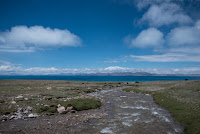 |
| With just one glance back, the yaks lumbered out of our lives forever |
19 June:
 |
| Breaking camp |
 |
| Gary looking cool just slightly below 15,000' |
Back in Lhasa (~ four hour van drive -- stopping for lunch en route): we checked back into the Kyi-chu for showers (it took more than one to get clean), sink-washed some clothes, napped and re-emerged for a quick dinner.
Note: This return to Lhasa is a day early to accommodate our missed visit to the Potala.
20 June:
 |
| Drepung |
 |
| View from the Drepung Assembly Hall |
In the morning we visited Drepung Monastery, which is built into a mountainside on what was once a remote site just west of Lhasa center. In these times, the monastery with its many chapels and universities seems to sprout in a series of white cones (the word drepung is translated as rice heap -- referencing the piled appearance of the white buildings), from its verdant green garden root, which is in turn ringed by the urban bustle of ever-expanding Lhasa. Once among the world's largest monasteries, now only about 300 monks out of the pre-invasion resident population of more than 7,000 remain.
In the afternoon we cruised the now somewhat familiar streets of the Tibetan Quarter of Lhasa -- returning to the Barkhor for a few more photos, while Gary, Tinsley and Dharma worked to get our Potala visit back on the itinerary.
21 June: We convened after a hotel breakfast with the intent of visiting the Dropenling Handicraft Center -- a small and hard-to-locate collection of shops within a shop, promoting the handmade crafts of Tibetans. This shop is the retail front for a free-trade and handicraft development initiative. But the Dropenling excursion will have to wait as there is word we can visit the Potala Palace.
 |
| Potala Palace |
 |
| View of Potala from the street |
The Potala Palace is an absolute landmark in Lhasa. If ever you have seen a picture of the city, you have seen a picture of this imposing structure. It is a true testament to its size and grandeur that even today, surrounded by the hub of urban Lhasa, it rises above the streets breathtakingly large and beautiful. The Potala was the home to every Dalai Lama from the fifth to the fourteenth (winter residence only following the completion of Norbulingka in the 18th Century). The magnificent fortress-like structure includes more than a thousand rooms (only a couple of dozen are open -- leaving many to believe there may be great damage or even evident theft in those unseen). Photos of the open chambers and temples of the Potala are expressly prohibited -- and there are security cameras at every turn and twist to enforce the rule.
Bottom line: The Potala Palace was stunning -- even given the crowd, high security, unsettling mix of tourists and pilgrims, and many (many) sealed rooms. Stunning, but for me, not spiritual. The uninhabited museum-like atmosphere, gross commercialization, graft and bribery necessary to gain entry and in-your-face Chinese revisionist history of the 1950s liberation of Tibet housed there made my heart ache.
 |
| Forget this revisionist history -- our brains may be oxygen deprived, but they're not dead! |
23 June: Our return trip is long, long, long (more books, more movies, more lousy inflight meals). But, thanks to the International Dateline, we arrive back in Denver the same date we depart China. We are safely home to Munro and Illy in Santa Fe before midnight.
***************************************************
Now can I say, Tibet was the trip of a lifetime? Still too much world to see. A trip of my lifetime, indeed. Going there felt important to me. My Tibet itch is scratched. I wish we could have visited 20 years ago, glad we didn't wait two more . . .
Today, due to the massive Chinese population transfer, the nation of Tibet truly faces the threat of extinction, along with its unique cultural heritage of Buddhist spirituality. ~ The Fourteenth Dalai Lama












































